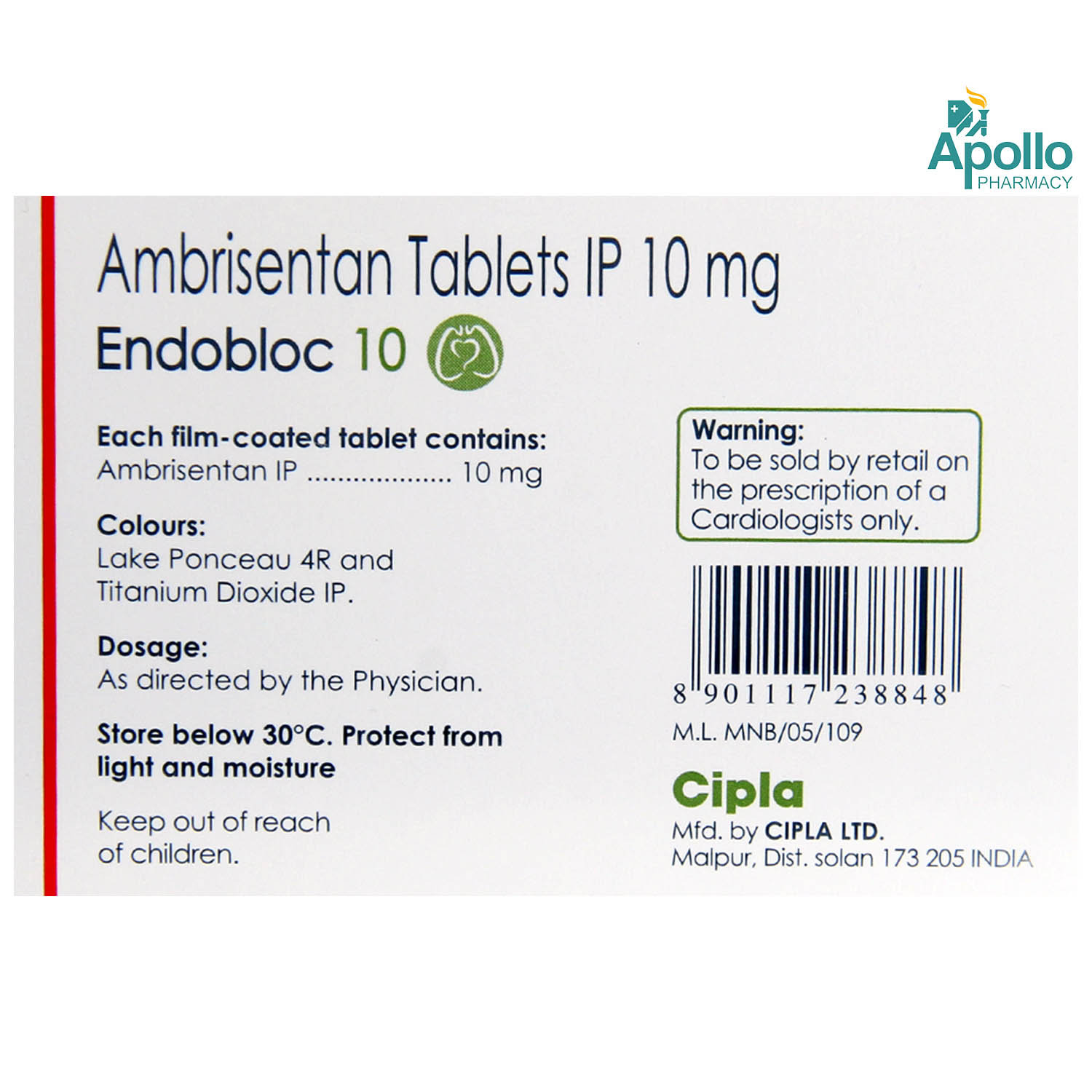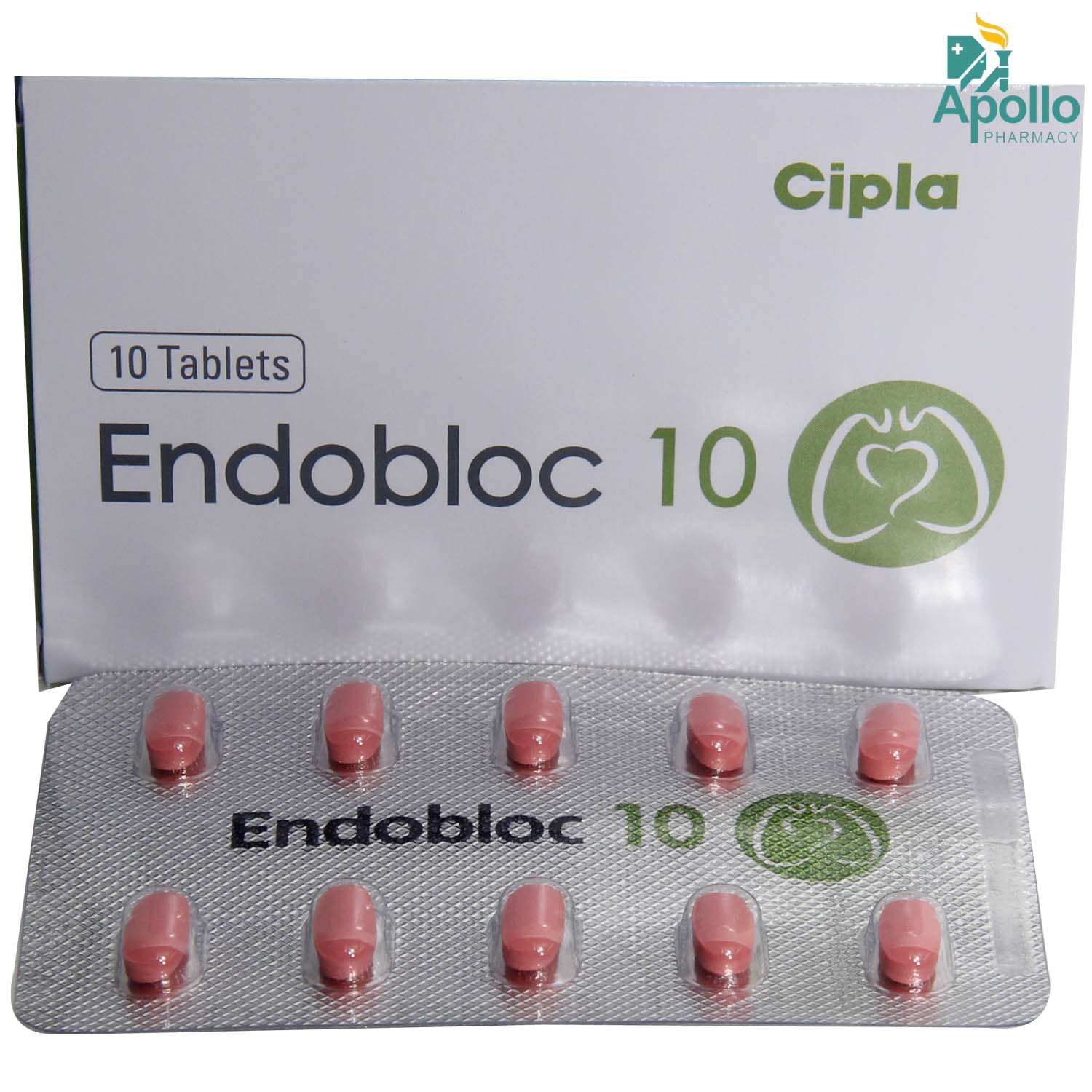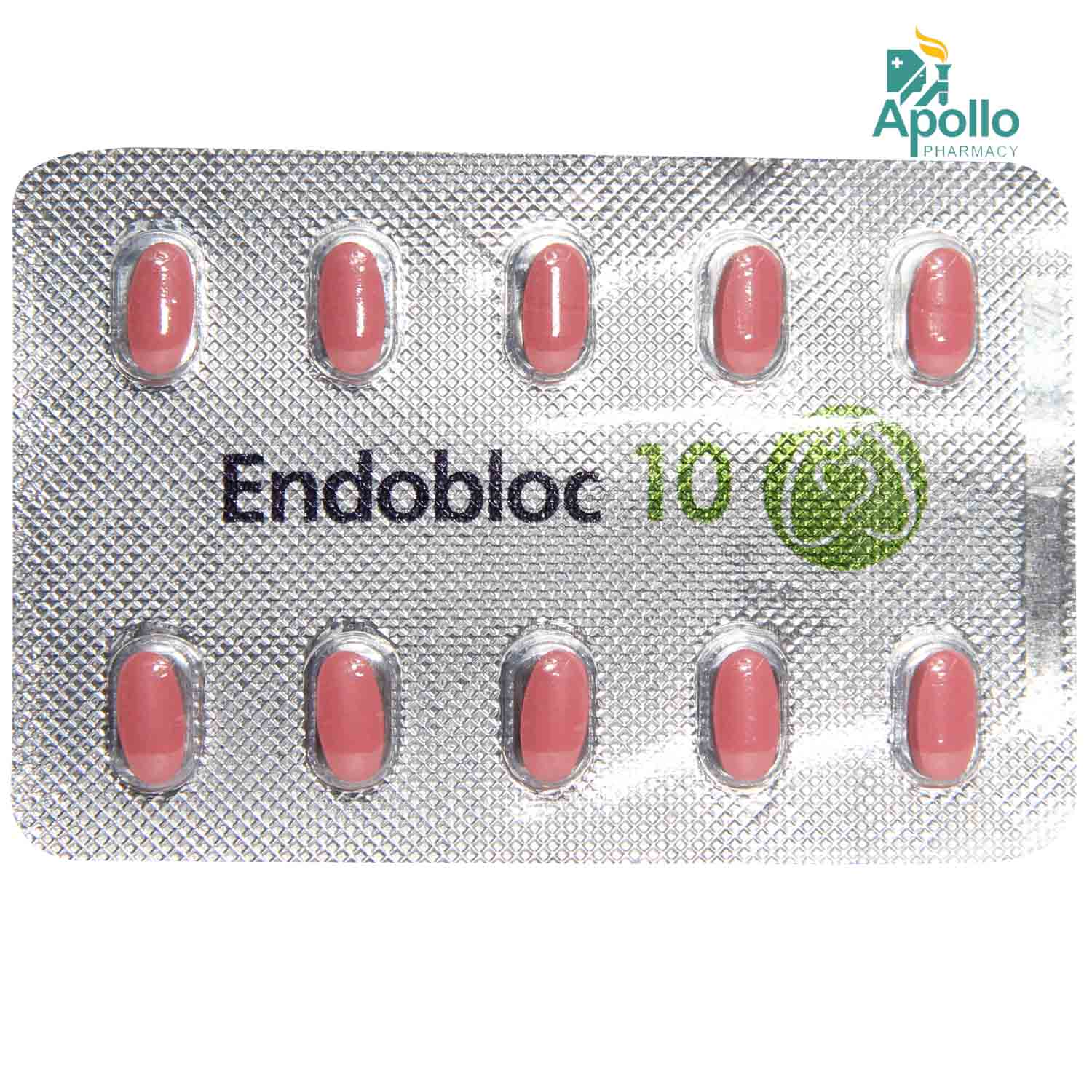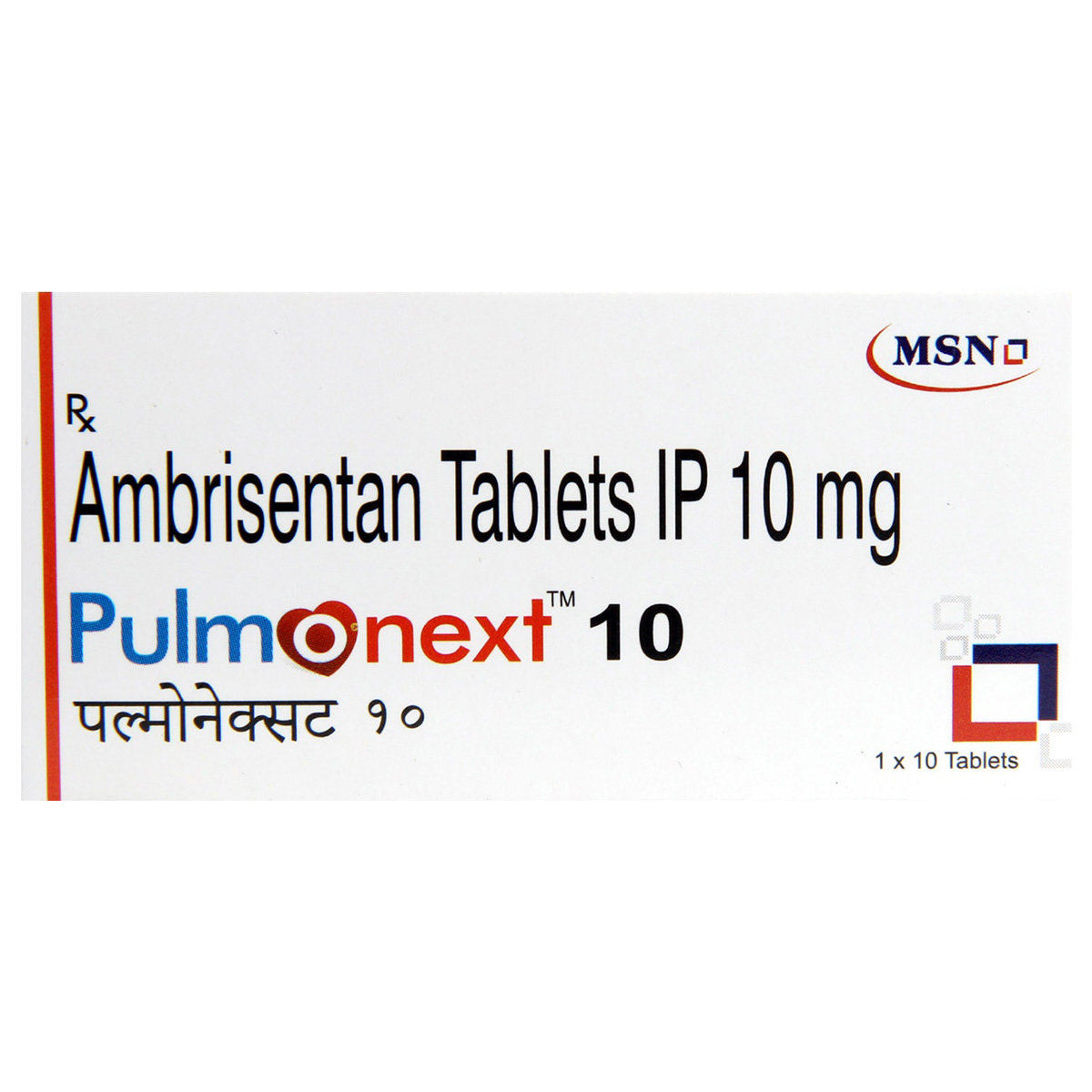ENDOBLOC 10MG TABLET
MRP ₹3240
(Inclusive of all Taxes)
₹486.0 Cashback (15%)
Provide Delivery Location
Online payment accepted
 Prescription drug
Prescription drugWhats That
 19 people bought
19 people bought Composition :
Manufacturer/Marketer :
Consume Type :
Expires on or after :
Return Policy :
About ENDOBLOC 10MG TABLET
ENDOBLOC 10MG TABLET belongs to the class of ‘anti-hypertensive drugs’, primarily used to treat high blood pressure in the arteries of lungs (pulmonary arterial hypertension). Hypertension is a medical condition, in which the blood exerts high pressure (force exerted by circulating blood) against the walls of blood vessels. This condition makes the heart to work harder in pumping the blood to the whole body. Pulmonary hypertension affects arteries in the lungs and the right side of the heart.
ENDOBLOC 10MG TABLET contains ‘Ambrisentan,’ which belongs to the class of ‘endothelin receptor blockers’. Ambrisentan works by inhibiting the action of Endothelin, a natural substance that constricts blood vessels and raises blood pressure. ENDOBLOC 10MG TABLET widens the constricted pulmonary arteries (blood vessels that carry blood from the heart to the lungs) and increases blood supply to the lungs, thus lowering the blood pressure.
In some cases, ENDOBLOC 10MG TABLET can cause side effects like headache, dizziness, palpitations, breathlessness, runny nose, feeling sick, diarrhoea, and fatigue. These side effects are not familiar to everyone and vary individually. If you notice any side effects that are not manageable, please consult your doctor.
Please inform your doctor if you are using any prescription, non-prescription drugs, including vitamins and herbal products. Let your doctor know if you have any allergic reactions to ENDOBLOC 10MG TABLET or any other medicines, before starting ENDOBLOC 10MG TABLET. Inform your doctor if you have low blood pressure, lung, heart, kidney or liver problems, and anaemia (lack of blood cells). It is advised to consult a doctor if you are a pregnant or breastfeeding mother. Do not stop taking ENDOBLOC 10MG TABLET without consulting your doctor since it may worsen your condition and increase the risk of future heart problems. Do not consume alcohol with ENDOBLOC 10MG TABLET as it may increase the risk of low blood pressure.
Uses of ENDOBLOC 10MG TABLET
Directions for Use
Key Benefits
ENDOBLOC 10MG TABLET is an anti-hypertensive medicine that treats high blood pressure in the arteries of lungs (pulmonary arterial hypertension (PAH)). It contains ‘Ambrisentan,’ an endothelin receptor blocker. ENDOBLOC 10MG TABLET works by inhibiting the action of Endothelin, a natural substance that constricts blood vessels and raises blood pressure. In people with PAH, the pulmonary arteries get narrower making the heart work harder to pump blood through them. ENDOBLOC 10MG TABLET widens these constricted arteries and makes it easier for the heart to pump blood, thus lowering the blood pressure.
Storage
Drug Warnings
Brief your medical history if you have heart failure, liver or kidney diseases, lung conditions (pulmonary fibrosis), anaemia, oedema (fluid retention) and hypotension (low blood pressure) before starting ENDOBLOC 10MG TABLET. ENDOBLOC 10MG TABLET is contraindicated during pregnancy since it has harmful effects on the foetus. Consult your doctor before using ENDOBLOC 10MG TABLET if you are a breastfeeding mother. Complete the course strictly as suggested by the doctor, even if you feel better, to avoid disease recurrence. Do not drive or operate machinery since ENDOBLOC 10MG TABLET may cause side effects like dizziness and weakness, affecting your ability to concentrate and drive. Avoid consumption of alcohol with ENDOBLOC 10MG TABLET as it may increase the risk of low blood pressure. ENDOBLOC 10MG TABLET is not recommended in patients younger than 18 years of age.
Diet & Lifestyle Advise
- Reduce sodium intake in your diet to maintain your blood pressure.
- Eat natural and healthy foods by cutting down on high on sodium processed foods.
- Lose those extra pounds, since being obese can be a risk factor for hypertension.
- Exercise regularly to maintain good heart health.
- Avoid smoking and alcohol intake.
- Chronic stress may also cause high blood pressure. Therefore, avoid stress triggers and make time for yourself to relax and do activities that you enjoy.
- Try to include heart-healthy omega 3 fatty acids containing food drinks in your daily diet. You can also use low-fat cooking oil like olive oil, soybean oil, canola oil and coconut oil to lower your elevated blood pressure.
- Limit sodium chloride intake (table salt) in your daily diet to 2300 mg per day or less than 1500 mg is ideal for most adults.
Side Effects of ENDOBLOC 10MG TABLET
- Headache
- Dizziness
- Swelling in your hands, legs, ankles, or feet
- Palpitations
- Breathlessness
- Chest pain or discomfort
- Stuffy nose, sinus pain
- Flushing (redness of the skin)
- Feeling sick
- Diarrhoea
- Feeling tired
- Rash
Habit Forming
Therapeutic Class
All Substitutes & Brand Comparisons
RX
Out of StockZambri 10mg Tablet
Zydus Cadila
₹2350
(₹211.5 per unit)
20% CHEAPERRX
PULMONEXT 10MG TABLET
Msn Laboratories Pvt Ltd
₹3212
(₹263.38 per unit)
Author Details
We provide you with authentic, trustworthy and relevant information
FAQs
Drug-Drug Interactions Checker List
- EPOPROSTENOL
- SILDENAFIL
- RIFAMPICIN
- CYCLOSPORINE
- ILOPROST
Special Advise
- Keep a check on your daily blood pressure and if you notice any fluctuations, please consult a doctor.
- You may be asked by your doctor to undergo blood and urine tests if you have been suffering from vomiting or dehydration.
- If you have diabetes, using ENDOBLOC 10MG TABLET may affect your blood sugar levels. Inform your doctor so that your diabetes medication may be adjusted accordingly.
- Your dietician may prescribe you a suitable exercise program and diet to manage your blood pressure.
- Your doctor may also suggest liver function tests since ENDOBLOC 10MG TABLET may cause a change in liver enzymes.
Disease/Condition Glossary
Hypertension: It is a medical condition in which blood pressure is elevated persistently in the arteries. It is considered as an essential risk factor for cardiovascular diseases and can be caused due to obesity, diabetes, smoking, high salt intake, stress, lack of physical activity or ageing. Blood pressure is measured in the ratio of systolic pressure to diastolic pressure. Systolic pressure is the pressure when the heart pumps blood out. On the other hand, diastolic pressure is the pressure when your heart is at the resting stage between heartbeats. If your blood pressure is 140/90 mm of Hg, it means the systolic pressure is 140 mm of Hg and, diastolic pressure is 90 mm of Hg. Ideal blood pressure range lies in between 90/60 mmHg and 120/80 mmHg. If the blood pressure is 140/90 mmHg or greater, it is considered high blood pressure.
Pulmonary Arterial Hypertension: It is referred to as high blood pressure in the blood vessels (the pulmonary arteries) that carry blood from the heart to the lungs. Symptoms include shortness of breath, dizziness, and chest pressure.

Have a query?
Alcohol
Safe if prescribed
It is advised to limit alcohol intake, since alcohol consumption with ENDOBLOC 10MG TABLET may increase the risk of low blood pressure and cause adverse effects, such as dizziness, fainting, light-headedness or headache.
Pregnancy
Consult your doctor
ENDOBLOC 10MG TABLET is not recommended and unsafe in pregnancy. It can affect and harm the developing baby. You are advised to get a pregnancy test done before starting ENDOBLOC 10MG TABLET. You should get a negative pregnancy test for sure before using ENDOBLOC 10MG TABLET. Also, please use reliable forms of birth control if you are undergoing treatment with ENDOBLOC 10MG TABLET to avoid pregnancy.
Breast Feeding
Consult your doctor
It is not known if ENDOBLOC 10MG TABLET is excreted into the breast milk. Please consult your doctor for more information before taking ENDOBLOC 10MG TABLET if you are a nursing mother.
Driving
Safe if prescribed
ENDOBLOC 10MG TABLET may cause side effects like dizziness and weakness, affecting your ability to concentrate and drive. Hence, it is recommended not to drive or operate machinery until you are mentally alert.
Liver
Consult your doctor
Let your doctor know if you have any history of liver diseases before taking ENDOBLOC 10MG TABLET. ENDOBLOC 10MG TABLET may cause an increase in liver enzymes. If you are using ENDOBLOC 10MG TABLET and experience any nausea, vomiting, loss of appetite, dark-coloured urine and yellowing of the skin, please see your doctor immediately.
Kidney
Consult your doctor
ENDOBLOC 10MG TABLET should be used with caution in cases of renal impairment. It is advised to seek doctor advice before starting ENDOBLOC 10MG TABLET if you have any kidney problems.
Children
Safe if prescribed
Safety and effectiveness of ENDOBLOC 10MG TABLET have not been established in patients below 18 years of age.
















